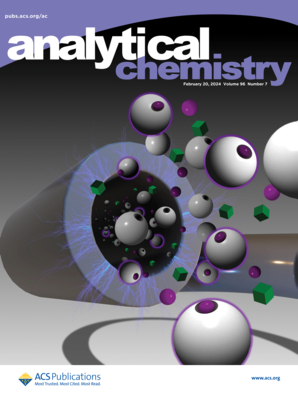Data-Independent Acquisition Coupled with Electron-Activated Dissociation for In-Depth Structure Elucidation of the Fatty Acid Ester of Hydroxy Fatty Acids
IF 6.7
1区 化学
Q1 CHEMISTRY, ANALYTICAL
引用次数: 0
Abstract
Fatty acid esters of hydroxy fatty acid (FAHFAs) are a biologically important class of lipids known for their anti-inflammatory and antidiabetic effects in animals. The physiological activity of FAHFAs varies depending on the length of the carbon chain, number and position of double bonds (DBs), and position of the hydroxyl (OH) group. Moreover, gut bacteria produce FAHFAs with more diverse structures than those produced by the host, which necessitates a FAHFA-lipidomics approach grasping their diverse structures to fully understand the physiological and metabolic significance of FAHFAs. In this study, we developed a methodology for the in-depth structural elucidation of FAHFAs. First, FAHFAs were enriched by using a solid-phase extraction (SPE) system coated with titanium and zirconium dioxide, which separated these analytes from neutral lipids and phospholipids. The fractionated metabolites were then derivatized using N,N-dimethylethylenediamine (DMED) to facilitate FAHFA detection in the positive ion mode of a liquid chromatography-tandem mass spectrometry (LC-MS/MS) system. A data-independent acquisition technique known as sequential window acquisition of all theoretical mass spectra (SWATH-DIA) was used to collect sequential MS/MS spectra of the DMED-derivatized fatty acid metabolites. Structural elucidation was based on fragment ions generated by electron-activated dissociation (EAD). DMED-FAHFAs were annotated using the newly updated MS-DIAL program, and FAHFA isomers were quantified using the MRMPROBS program, which quantifies lipids based on SWATH-MS/MS chromatograms. This procedure was applied to profile the FAHFAs present in mouse fecal samples, characterizing seven structures at the molecular species level, 63 structures at the OH-position-resolved level, and 15 structures at both the DB- and OH-position-resolved levels, using the MS-DIAL program. In the MRMPROBS analysis, 2OH and 3OH hydroxy fatty acids with more than 20 carbon atoms were predominantly expressed, while 5OH–13OH hydroxy fatty acids with 16 or 18 carbon atoms were the major components, abundant at positions 5, 7, 9, and 10. Furthermore, age-related changes in FAHFA isomers were also observed, where FAHFA 4:0/2O(FA 26:0) and FAHFA 16:0/10O(FA 16:0) significantly increased with age. In conclusion, our study offers a novel LC-SWATH-EAD-MS/MS technique with the update of computational MS to facilitate in-depth structural lipidomics of FAHFAs.

数据独立采集与电子激活解离相结合对羟基脂肪酸脂肪酸酯的深入结构解析
羟基脂肪酸脂肪酸酯(FAHFAs)是一类生物学上重要的脂类,以其抗炎和抗糖尿病作用而闻名。FAHFAs的生理活性取决于碳链的长度、双键的数量和位置以及羟基的位置。此外,肠道细菌产生的fahfa结构比宿主产生的更多样化,这就需要利用fahfa -脂质组学的方法来掌握它们的多样性结构,以充分了解fahfa的生理和代谢意义。在这项研究中,我们开发了一种深入阐明fahfa结构的方法。首先,利用钛和二氧化锆包覆的固相萃取(SPE)系统富集FAHFAs,将这些分析物与中性脂质和磷脂分离。然后用N,N-二甲基乙二胺(DMED)衍生化分馏代谢物,以便在液相色谱-串联质谱(LC-MS/MS)系统的正离子模式下检测FAHFA。采用数据无关的全理论质谱序列窗口采集技术(SWATH-DIA)收集dmed衍生脂肪酸代谢物的序列质谱。结构解析是基于电子激活解离(EAD)产生的碎片离子。使用最新更新的MS- dial程序对dmed -FAHFA进行注释,使用MRMPROBS程序对FAHFA异构体进行定量,MRMPROBS程序基于SWATH-MS/MS色谱图定量脂质。使用MS-DIAL程序分析小鼠粪便样品中存在的FAHFAs,表征了分子种水平的7种结构,oh -位置分辨水平的63种结构,以及DB和oh -位置分辨水平的15种结构。MRMPROBS分析中,碳原子数大于20的2OH和3OH羟基脂肪酸以表达为主,而碳原子数为16或18的5OH-13OH羟基脂肪酸是主要成分,在第5、7、9和10位富集。此外,还观察到FAHFA异构体的年龄相关变化,其中FAHFA 4:0/ 20 (FA 26:0)和FAHFA 16:0/10 (FA 16:0)随着年龄的增长而显著增加。总之,我们的研究提供了一种新的LC-SWATH-EAD-MS/MS技术,并更新了计算质谱,以促进fahfa的深入结构脂质组学。
本文章由计算机程序翻译,如有差异,请以英文原文为准。
求助全文
约1分钟内获得全文
求助全文
来源期刊

Analytical Chemistry
化学-分析化学
CiteScore
12.10
自引率
12.20%
发文量
1949
审稿时长
1.4 months
期刊介绍:
Analytical Chemistry, a peer-reviewed research journal, focuses on disseminating new and original knowledge across all branches of analytical chemistry. Fundamental articles may explore general principles of chemical measurement science and need not directly address existing or potential analytical methodology. They can be entirely theoretical or report experimental results. Contributions may cover various phases of analytical operations, including sampling, bioanalysis, electrochemistry, mass spectrometry, microscale and nanoscale systems, environmental analysis, separations, spectroscopy, chemical reactions and selectivity, instrumentation, imaging, surface analysis, and data processing. Papers discussing known analytical methods should present a significant, original application of the method, a notable improvement, or results on an important analyte.
 求助内容:
求助内容: 应助结果提醒方式:
应助结果提醒方式:


